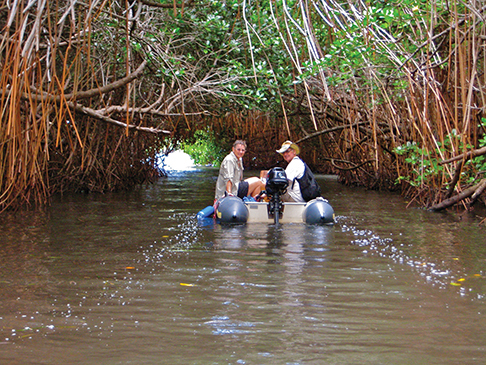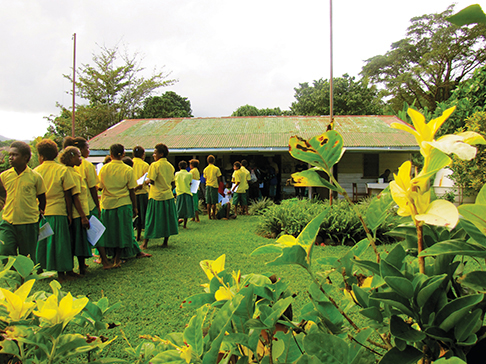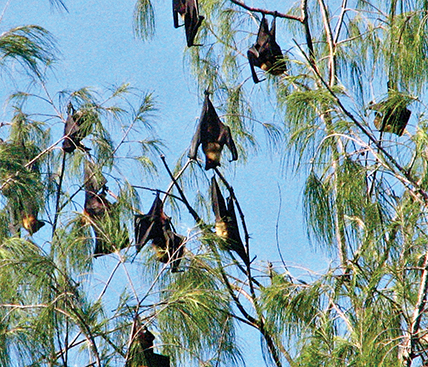Learning about malaria’s lesser known cousins, Russ River virus and dengue fever (co-written with Abby Young, published January 2013)
My wife Rozlynn and I made landfall in Brisbane, Australia, completing the second year of an open-ended world cruise that began in San Francisco. After 40 years of coastal sailing, we retired from our professional lives and moved aboard Worrall Wind, our Siltala Nauticat 44 Ketch. Rozlynn had successfully battled breast cancer and we were both in robust pyhsical condition, so we pledged to sail westward following the sunsets until we stopped having fun or our health made sailing no longer possible.
As we approached Australia, it appeared the stress of sailing and age was closing in on our wake. I suddenly began experiencing joint pain that made sailing and maintaining our 25-year-old ketch difficult. If the symptoms worsened, I would no longer be able to pretzel into the engine compartment, climb the mast or simply winch in a sheet.
The Search for a diagnosis
Most cruisers have taken EMT or offshore medical courses to be able to recognize and manage trauma and serious medical emergencies, but may lack knowledge of age-related and other medical conditions, including tropical diseases. In these less dramatic conditions, history including previous injuries, medical problems and current medications, as well as the onset, nature and course of symptoms are important in solving the diagnosis puzzle.

Six weeks earlier in Vanuatu, the arthritic-like symptoms started with mild fatigue but no fever. Pain in my hips made getting off the head difficult and my wife and friends noticed I had developed a slight limp favoring my right leg while walking. My wife offered the “diagnosis” of age-related arthritis and suggested naproxen or ibuprofen, which resulted in moderate relief. I was two months shy of 65—was this what the golden years were all about?
In my case, age-related osteoarthritis fit for age but not in other ways. I had my share of joint wear and tear after 40 years of ski patrol work, mountain biking and sailing, but I have not had joint problems in recent years. I consider myself to be in good medical and physical health, so the sudden onset of symptoms was a surprise.
After several weeks, the condition changed course with an easing of the hip pain but the development of moderate pain in both knees and my right shoulder. Rozlynn and I had completed the PADI Open Water Course in Fiji a month prior to the onset of my symptoms and had been diving with friends in Vanuatu. Could I have suffered decompression illness, or “the bends”? A call to the Divers Alert Network (DAN) medical advisor suggested this was not likely since more than two joints were involved and the symptoms did not occur within 24 hours of diving. He suggested that the hip discomfort may have resulted from the kicking movement required with fins, stressing my old joints and muscles in new ways. The other pains, he said, might be a result of handling the heavy dive gear, aggravating old injuries such as my previously dislocated left shoulder.
I made a Skype call to my daughter, Abby, who is an emergency room physicican in the Air Force. She said the migratory arthritis I was describing could be caused by different systemic conditions such as Lyme disease, rheumatic fever, lupus or many other tropical infections. In the absence of fever or other acute symptons, she suggested continuing the over the counter naproxen and seeing my doctor when I returned home to San Francisco for a holiday visit. When I made the visit to my doctor a month later, the symptoms were gradually resolving though migrating around—affecting an elbow or hand and not my shoulder. A routine physical and blood work-up were normal. My doctor recommended continuing the naproxen and asked me to return if the symptoms worsened, saying he would refer me to a rheumatologist for further testing and treatment.
Mystery Solved?
Soon after, I received an e-mail from my daughter: I may have a diagnosis! Ross River virus (RRV). Abby explained that the main sympton of RRV, which is also known as polyarthritis and is endemic to South Pacific islands and Australia, is migratory arthritis. Professor Ralph Doherty first described RRV in 1963 in patients living along the Ross River in Queensland. RRV is transmitted by mosquitoes between animal hosts, such as the fruit bat, and is not directly contagious among humans. The incubation period is five to 10 days. Although joint pain that moves about is the primary symptom, RRV may begin with a mild fever (less than 102°F) and rash. The symptoms can be debilitating, but are non-life-threatening.
There is now a blood test for RRV antibodies, but there is no treatment other than pain relief with non-steroidal anti-inflammatory drugs such as naproxen. Prednisone, although effective, is not recommended due to its many side effects. The good news is that RRV is self-limiting. The bad news is that it persists from two to six months. It is interesting to note that indigenous populations seem immune because they get it as kids—adult travelers like me are its primary victims.

Other possibilities
In tropical areas, many other mosquito-borne diseases are common, and these differ from RRV in their symptoms. Two of the more serious illnesses that should concern cruisers are dengue fever and malaria.
Dengue fever, which Abby contracted in Costa Rica, is a febrile viral disease. Although usually a mild illness similar to the flu, some people (like Abby) suffer acute sudden onset symptoms including high fever (104-105° F), chills, headache (typically located behind the eyes), muscle and joint pain, and a rash lasting seven to 14 days. The fever can recur two or three times. Vomiting and diarrhea may be severe, and mild bleeding from the mucous membranes of the mouth and nose may occur. In rare cases, the disease can progress to severe dehydration and the more deadly dengue hemorrhagic fever. There is no specific treatment, but oral or intravenous rehydration is critical and fever control with acetaminophen is suggested. Aspirin and ibuprofen should be avoided due to their tendency to increase bleeding. Resolution often occurs quickly. The high fever and severe joint and muscle pain that resulted in the name “break bone fever” differentiate dengue from Ross River virus.

Malaria, a parasitic disease, is the best known and the most deadly tropical disease. The symptoms, which include high fever, headache, chills, joint pain, vomiting and diarrhea, can present within seven to 28 days of exposure, but may show up as late as a year after being infected. The symptons recur in cycles of 48 to 72 hours. Severe anemia, convulsions and coma may ensue. Treatment with drugs and hydration must be started within two days. Few cruisers carry anti-malarial drugs, but in some areas prophylactic treatment may be conducted with drugs such as atovaquone, doxycycline or mefloquine.

Prevention: the best treatment
There are many insect-borne diseases. Prevention is the best defense through the covering of the body when outdoors, using treated bed nets, and the liberal use of insect repellents such as those containing DEET. The July 2010 Consumer Reports found a direct correlation between DEET concentration and hours of protection against insect bites. 100% DEET was found to offer up to 12 hours of protection, while several lower concentration DEET formulations (20-34%) offered three to six hours of protection. The U.S. Center for Disease Control recommends 30-50% DEET to prevent the spread of pathogens carried by insects. Many other tropical diseases such as cholera may be avoided with good hygiene and food preparation practices.
Rozlynn and I are returning to Australia to continue our westward adventure. My symptoms have resolved over the past five months. As we venture into Indonesia and beyond, we will be more diligent in our prevention of mosquito-borne disease. We were fortunate that only one of us became the victim of the Ross River virus and not a more cruise- or life-ending disease.
Russ Worrall is co-captain of Worrall Wind, his Siltala Nauticat 44 Ketch, with his wife Rozlynn. Russ is a retired optometrist and professor at the University of California, Berkeley and was an active member of the National Ski Patrol for 45 years and an instructor in the Outdoor Emergency Care program.
Abby Young is a Captain and ER physician in the United States Air Force. She completed her residency in emergency medicine at the University of Nevada, Las Vegas and has a special interest in wilderness medicine.
Vital Sources
Ross River Fever Factsheet: www.health.nsw.gov.au/factsheets/infectious/rossriver.html
World Health Organization: www.who.int/mediacentre/factsheets/fs117/en/
Centers for Disease Control and Prevention: www.cdc.gov/malaria

















